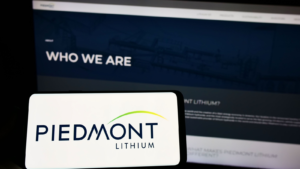Source: tunasalmon / Shutterstock.com
Lithium stocks have plunged on the back of a massive meltdown in prices. The dominant sentiment for lithium is fear, as investors stay away from the best lithium stocks to buy at deeply undervalued levels. As a value investor, this is a golden buying opportunity.
Of course, it’s not the time to go overboard. However, I would certainly recommend the gradual accumulation of high-quality lithium stocks. Last year, BMI indicated that a global lithium shortage could come as early as 2025. Further, a 2022 report by Boston Consulting Group estimates that the lithium supply gap will be at least 1.1 million metric tons by 2035.
There can be deviations from these estimates, with EV adoption being slower than expected. However, there is no doubt that the supply-demand scenario will remain tight in the long term. This will translate into higher lithium prices.
Let’s, therefore, talk about three lithium stocks to buy and hold for multibagger returns potential.
Lithium Americas (LAC)

Source: Wirestock Creators / Shutterstock.com
Lithium Americas (NYSE:LAC) had a strong breakout rally in the first few months of the year. The upside was backed by a loan commitment of $2.26 billion from the U.S. Department of Energy to finance the construction of the Thacker Pass project.
The rally, however, fizzled out, with negative industry sentiments being dominant. A $275 million equity offering also accelerated the downside. The renewed correction is a good opportunity to accumulate the stock. Considering the Thacker Pass asset potential, LAC stock will likely be a 5-bagger or 10-bagger by 2030.
To put things into perspective, the asset has a mine life of 40 years. Furthermore, Lithium Americas will likely deliver an annual EBITDA of $2 billion once both phases are operational. Therefore, cash flow will be robust after commercialization. With the project financing gap closed, the focus is likely to be on the long-term value creation.
Albemarle (ALB)

Source: IgorGolovniov/Shutterstock.com
After a deep correction, Albemarle (NYSE:ALB) stock finally seems to have found a bottom. ALB stock has been higher by 11% in the last six months. I believe further consolidation and a breakout on the upside are likely in the next few quarters.
For Q1 2024, Albemarle reported sales and adjusted EBITDA of $1.4 billion and $291 million, respectively. On a year-on-year basis, sales declined sharply, coupled with margin compression. However, energy storage volume growth offsets the negatives to some extent.
An important note is that Albemarle ended the quarter with a liquidity buffer of $3.7 billion. Further, net-debt-to-adjusted EBITDA was 0.9. Therefore, financial flexibility is high for aggressive investments once lithium recovers.
It’s worth noting that Albemarle has maintained its guidance for 20% CAGR in lithium sales volume growth through 2027. I, therefore, expect stellar growth and cash flow upside in the coming years once lithium stages a strong recovery.
Piedmont Lithium (PLL)

Source: T. Schneider / Shutterstock.com
Piedmont Lithium (NASDAQ:PLL) has been the worst performer among the lithium stocks discussed. PLL stock has plunged by 77% in the last 12 months. The worst is over, and the company is trading at a deep valuation gap.
The asset valuation approach underscores my view. Currently, Piedmont Lithium commands a market valuation of $255 million. The company’s Ghana asset has an after-tax net present value of $1.3 billion. Further, the Carolina and Tennessee assets have a combined after-tax NPV of $4.5 billion.
Investors will wonder why PLL stock has plunged. An obvious reason is the decline in lithium prices. Further, Piedmont would require significant financing to construct the game-changing assets. I expect PLL stock to go ballistic once the company has ample funds through debt-equity or joint venture. That’s likely when lithium prices start recovering and investments in lithium projects are renewed.
On the date of publication, Faisal Humayun did not hold (either directly or indirectly) any positions in the securities mentioned in this article. The opinions expressed in this article are those of the writer, subject to the InvestorPlace.com Publishing Guidelines.










